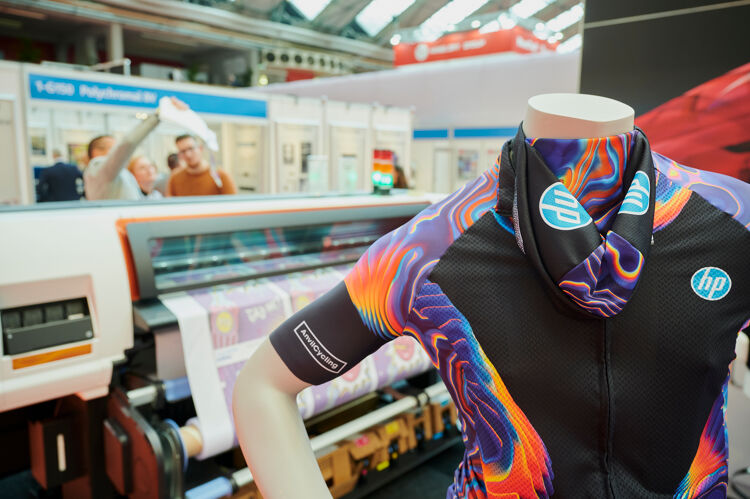It’s boom-time for digital textiles – are you ready for the opportunity?

Michael Ryan, Head of Global Print Expo at FESPA, discusses the growth opportunities, trends and technological developments in digital textile printing.
With the global digital textile print market set to reach $8 billion by 2030, new opportunities are opening up for enterprising print professionals. Thanks to technological advancements being made in roll-to-roll (R2R) and direct-to-garment (DTG) printing, many textile print producers have opted to replace their flat screen-printing machines in favour of more efficient digital textile printers.
Now is the ideal time for printers, regardless of their size, to assess their current technology set-up to see whether improvements can be made, enabling them to capitalise on this increase in demand for printed textiles. Let’s take a closer look at how the market for textile print is changing and why digital is fuelling its future.
One of the biggest drivers behind this significant growth in the textile print market is the rise of on-demand printing. Success comes to those printers that can meet and beat the turnaround times of others and adopt leaner and smarter ways of working. By keeping stock levels to a minimum, printers can enable customers to be more agile and respond to new market trends. Digital technologies also promote design diversity, eliminate waste and reduce the footprint of commercial manufacturing.
As the supply chain flexes to meet consumer demand, near-shore garment manufacture will gain traction and some producers are already choosing to bring technology in-house. In future, internationally sourced garments will be economically replaced by ‘home-grown’ products to reduce the carbon footprint of shipping costs and meet tighter turnaround times.
Thanks to digital technologies, we’re also seeing a burst of creativity in a generation of creative textile entrepreneurs. By using small scale, low-volume production machinery built for cottage industries, these textile producers have carved a niche for themselves, driven by e-commerce, great design and super-fast fulfilment.
Another sector that’s growing at a phenomenal pace is the DTG market. It's driving the fashion fulfilment business model whereby a print provider hosts online products for third-party production on behalf of designer-makers, offering them a turn-key manufacturing solution.
There have been improvements in printheads, such as the Ricoh GEN5 and the Xaar Nitrox, and further evolution in digital print processing, such as the Durst P5 in-line sublimation model. We’re also seeing a progression in ink handling, as exemplified by the Kornit XDi proposition and the DuPont Artistri 5500 inks.
There is equal progress in automation software which also has a big part to play in the reduction of production timescales in the custom garment sector. We’re seeing that the rate of adoption of digital printing technologies and software in traditional manufacturing operations is accelerating significantly. Using automation, customised garment production can be simplified as the software takes control of team logos, numbers, colours and other variable data with the touch of a button.
Across the industry, innovation continues and these advances are driving significant change. We are at a tipping point, a pivotal moment that offers the textile industry the toolbox, the technology, and the supply chain demand to move to environmentally responsible, efficient production.
At FESPA, we’re witnessing the impact that innovative technologies, automated processes and the increase in eco-friendly materials are having on textile production. We believe that digital technologies can make a huge impact, leading us into the next decade with enhanced processes, intelligent manufacturing, green production and smart retailing.
Digital textile print is the key to the future and will give PSPs the ability to unleash their creativity, delight their customers and create new revenue streams paving the way to future growth and profitability.
Make sure to keep up-to-date with the latest trends and advancements in textile printing via our FESPA.com news portal: https://www.fespa.com/en/news-media.
Topics
Interested in joining our community?
Enquire today about joining your local FESPA Association or FESPA Direct
Recent news

The importance of ink for large format printers
Ink is crucial for large format inkjet printers, influencing substrate compatibility, productivity, and cost. Nessan Cleary discusses the three main types which include UV-curable ink, latex ink and eco-solvent ink. Each ink type has specific strengths and weaknesses, making printers choice dependent on budget and intended applications.

What are the benefits of Direct-To-Fabric printing?
Direct-to-fabric printing is gaining popularity for high-volume textile production, enabling on-demand, customized short runs. These printers offer ink flexibility, accommodating various fabric types like cotton and silk, though ink development focuses on faster turnaround by reducing pre- and post-processing. Compared to traditional methods, direct-to-fabric inkjet printing is a more sustainable option due to reduced water and chemical usage, and localized production.

What are the opportunities for large format providers regarding digital touch screens?
Digital touchscreens are becoming increasingly common, offering businesses opportunities to improve customer engagement and streamline operations. Nessan Cleary shares, while more expensive to implement than standard digital displays due to complex software and integration needs, touchscreens provide self-service options, multilingual support, and can reduce staffing costs in various settings like retail, transportation, and healthcare.
